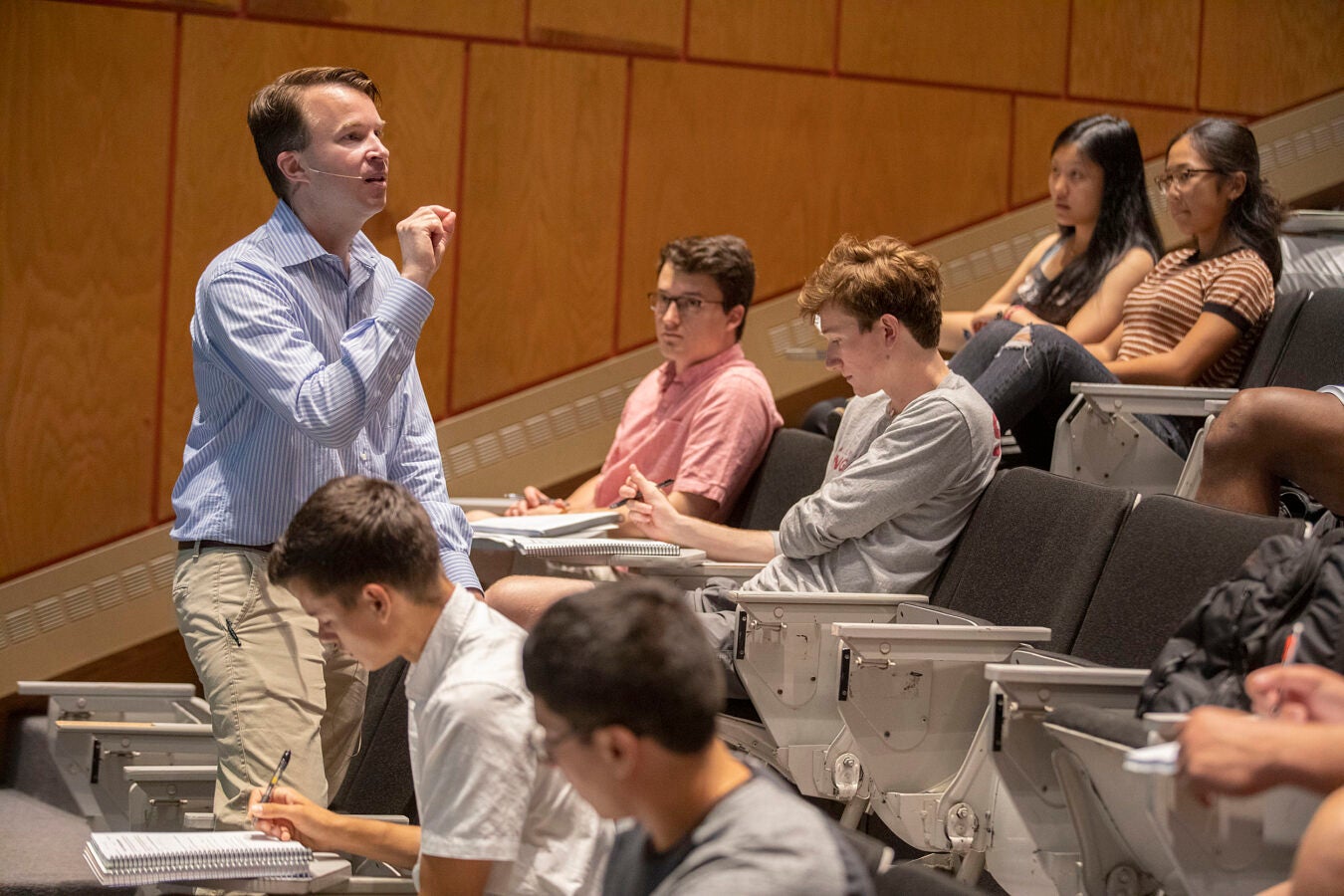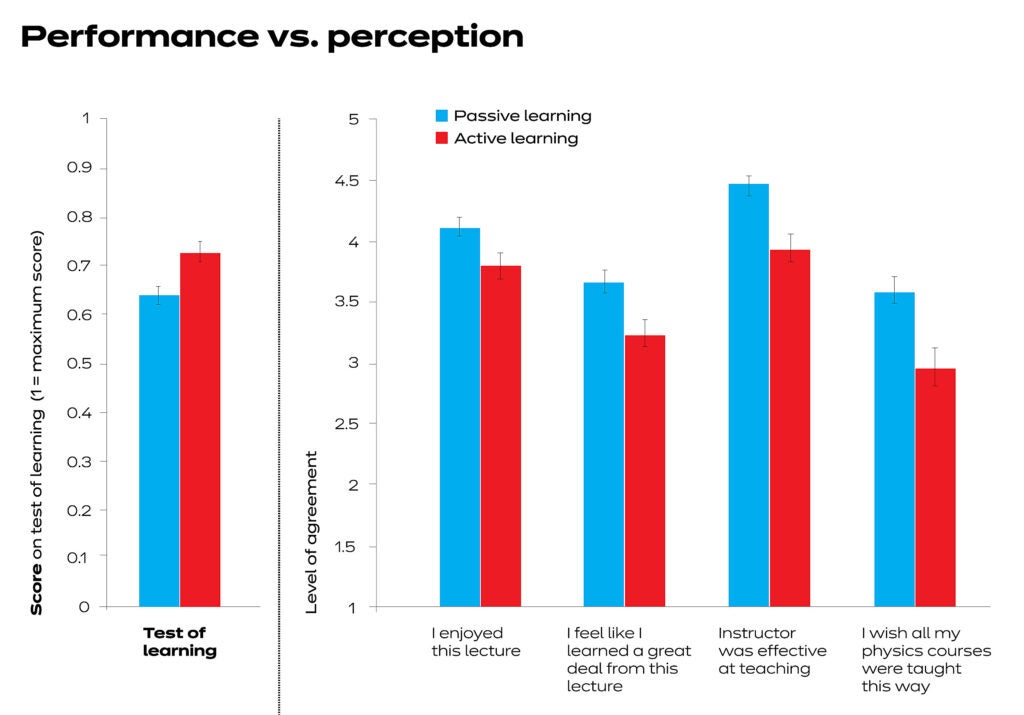Do Students Need To Always Upload Evidence In Linguafollio Online
Scientific discipline & Engineering science
Lessons in learning
Sean Finamore '22 (left) and Xaviera Zime '22 study during a lecture in the Science Center.
Photos by Kris Snibbe/Harvard Staff Photographer
Study shows students in 'active learning' classrooms learn more than they think
For decades, there has been prove that classroom techniques designed to get students to participate in the learning process produces better educational outcomes at virtually all levels.
And a new Harvard study suggests it may exist of import to let students know it.
The written report, published Sept. four in the Proceedings of the National Academy of Sciences, shows that, though students felt as if they learned more than through traditional lectures, they really learned more when taking part in classrooms that employed so-called active-learning strategies.
Atomic number 82 writer Louis Deslauriers, the director of science teaching and learning and senior physics preceptor, knew that students would larn more from active learning. He published a key study in Scientific discipline in 2011 that showed just that. Just many students and kinesthesia remained hesitant to switch to it.
"Often, students seemed genuinely to prefer smooth-as-silk traditional lectures," Deslauriers said. "We wanted to take them at their word. Mayhap they actually felt like they learned more than from lectures than they did from active learning."
In addition to Deslauriers, the study is authored by director of sciences education and physics lecturer Logan McCarty, senior preceptor in applied physics Kelly Miller, preceptor in physics Greg Kestin, and Kristina Callaghan, at present a physics lecturer at the University of California, Merced.
The question of whether students' perceptions of their learning matches with how well they're actually learning is particularly important, Deslauriers said, because while students somewhen run across the value of agile learning, initially it can feel frustrating.
"Deep learning is hard work. The effort involved in active learning can be misinterpreted every bit a sign of poor learning," he said. "On the other hand, a superstar lecturer can explain things in such a way every bit to make students feel like they are learning more than they actually are."

Director of sciences education and physics lecturer Logan McCarty is the co-author of a new written report that says students who accept part in active learning actually learn more than they remember they practice. Using these principles, he teaches Physical Science 12B in the Science Center.
To understand that dichotomy, Deslauriers and his co-authors designed an experiment that would expose students in an introductory physics class to both traditional lectures and active learning.
For the first 11 weeks of the 15-week form, students were taught using standard methods by an experienced instructor. In the 12th calendar week, half the class was randomly assigned to a classroom that used active learning, while the other half attended highly polished lectures. In a subsequent class, the two groups were reversed. Notably, both groups used identical course content and simply active date with the textile was toggled on and off.
Following each form, students were surveyed on how much they agreed or disagreed with statements such as "I feel like I learned a lot from this lecture" and "I wish all my physics courses were taught this fashion." Students were also tested on how much they learned in the class with 12 multiple-choice questions.
When the results were tallied, the authors constitute that students felt as if they learned more from the lectures, but in fact scored college on tests following the agile learning sessions. "Bodily learning and feeling of learning were strongly anticorrelated," Deslauriers said, "equally shown through the robust statistical analysis by co-writer Kelly Miller, who is an skillful in educational statistics and agile learning."
Those results, the report authors are quick to point out, shouldn't exist interpreted as suggesting students dislike active learning. In fact, many studies accept shown students quickly warm to the idea, once they begin to see the results. "In all the courses at Harvard that we've transformed to agile learning," Deslauriers said, "the overall class evaluations went up."

Source: "Measuring actual learning versus feeling of learning in response to being actively engaged in the classroom," Louis Deslauriers, Logan Southward. McCarty, Kelly Miller, Kristina Callaghan, and Greg Kestin
Co-author Kestin, who in improver to existence a physicist is a video producer with PBS' NOVA, said, "It tin exist tempting to engage the grade simply by folding lectures into a compelling 'story,' peculiarly when that's what students seem to similar. I prove my students the information from this report on the first mean solar day of class to assist them appreciate the importance of their own involvement in agile learning."
McCarty, who oversees curricular efforts beyond the sciences, hopes this report will encourage more of his colleagues to comprehend active learning.
"We want to make sure that other instructors are thinking hard about the way they're teaching," he said. "In our classes, we start each topic by asking students to assemble in small groups to solve some bug. While they work, nosotros walk effectually the room to observe them and answer questions. Then we come together and give a short lecture targeted specifically at the misconceptions and struggles we saw during the trouble-solving activity. And so far we've transformed over a dozen classes to use this kind of active-learning approach. It's extremely efficient — nosotros can comprehend just equally much material as we would using lectures."
A pioneer in work on agile learning, Balkanski Professor of Physics and Applied Physics Eric Mazur hailed the study as debunking long-held beliefs about how students learn.
"This work unambiguously debunks the illusion of learning from lectures," he said. "It also explains why instructors and students cling to the belief that listening to lectures constitutes learning. I recommend every lecturer reads this article."
Dean of Science Christopher Stubbs, Samuel C. Moncher Professor of Physics and of Astronomy, was an early convert. "When I first switched to pedagogy using active learning, some students resisted that change. This enquiry confirms that kinesthesia should persist and encourage active learning. Agile date in every classroom, led by our incredible scientific discipline faculty, should be the authentication of residential undergraduate education at Harvard."
Ultimately, Deslauriers said, the study shows that it's important to ensure that neither instructors nor students are fooled into thinking that lectures are the best learning option. "Students might give fabulous evaluations to an amazing lecturer based on this feeling of learning, even though their actual learning isn't optimal," he said. "This could help to explicate why written report subsequently study shows that student evaluations seem to be completely uncorrelated with bodily learning."
This research was supported with funding from the Harvard FAS Sectionalisation of Science.
Source: https://news.harvard.edu/gazette/story/2019/09/study-shows-that-students-learn-more-when-taking-part-in-classrooms-that-employ-active-learning-strategies/
Posted by: tellistharand.blogspot.com

0 Response to "Do Students Need To Always Upload Evidence In Linguafollio Online"
Post a Comment